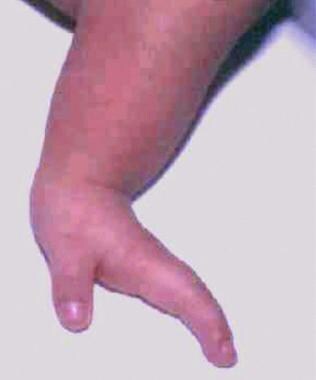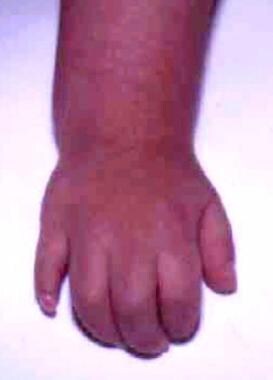History
Patient history
The course of pregnancy and delivery offer clues. Preterm delivery is noted in approximately 30% cases.
Retardation of growth is often profound and of prenatal onset. [40, 52, 53]
The difficulties in weight and height gain persist in the postnatal period as a result of feeding difficulties
Sucking and swallowing problems and an inability to take an appropriate amount of food for age in the first months of life result in failure to thrive.
Recurrent respiratory tract infections, hyperactivity, nocturnal agitation, and behavioral problems may be atypical manifestations of gastroesophageal reflux (GER).
A diminished responsiveness to pain has been reported and was found to be associated both with intellectual disability and with autism; it might contribute to self-injury behaviors.
Psychomotor development and behavioral findings
Most affected individuals with the classic phenotype have moderate-to-profound intellectual disability. [40, 54]
Borderline-to-mild deficiency is usually observed in patients who are mildly affected; near-normal intelligence has occasionally been recorded. [45, 40, 51]
The cognitive profile is characterized by lack of or delayed verbal communication, with specific deficits in expressive language; receptive language and verbal comprehension are less affected. Expressive language is not reached by a significant number of subjects; those who acquire verbal language do so late. [55, 56] Visuospatial memory and perceptual organization are usually normal.
The behavioral manifestations include a wide spectrum of symptoms, such as abnormal emotional response, sleep disturbances, daily aggression and hyperactivity, poor relationship abilities, stereotypies, rigidity, autism, and self-injury. Activities of daily living are significantly affected with aggression and hyperactivity. Communication and socialization deficits can deteriorate in adulthood. [40, 57, 58, 59, 60, 61, 56, 62, 63]
Physical Examination
Cornelia de Lange syndrome (CDLS) is a highly variable multiple congenital anomalies-intellectual disability (MCA-ID) syndrome, ranging from perinatal lethality with multiple malformations, including severe upper limb deficiency, to a degree of mildness compatible with reproduction and near-normal intellect. Diagnosis is based on the characteristic phenotype, in particular a striking facial gestalt, prenatal and postnatal growth retardation, various skeletal abnormalities, hypertrichosis, and developmental delay. [36, 48, 40, 64]
The phenotypic dichotomy, classic and mild cases, is now well established. The prognosis for patients with the mild phenotype is much better than that for patients with the classic form. [36, 48, 49, 65] A diagnostic scoring system for severity in CDLS has been proposed. [52]
The following is a classification system based on the clinical variability in CDLS:
-
CDLS type I (classic): Patients have the characteristic facial and skeletal changes, a prenatal growth deficiency that is progressive postnatally, moderate-to-profound psychomotor retardation, and major malformations resulting in severe disability or death.
-
CDLS type II (mild): Patients have facial and minor skeletal abnormalities similar to those seen in type I; however, they are distinguished by less severe psychomotor retardation and milder growth deficiency. The prognosis is more optimistic, but, paradoxically, behavior dysfunction may be more evident.
The following craniofacial characteristics are unique and of great diagnostic value:
-
Microbrachycephaly: The average head circumference remains less than the second percentile throughout life.
-
Low frontal hairline
-
Well-defined, arched "pencilled" eyebrows
-
Synophrys
-
Long, curly eyelashes
-
Short nose with anteverted nares
-
Triangular nasal tip
-
Long philtrum
-
Crescent-shaped mouth
-
Thin lips
-
Widely spaced (late-erupting) teeth
-
Micrognathia
-
Low-set and posteriorly rotated ears
See the images below.
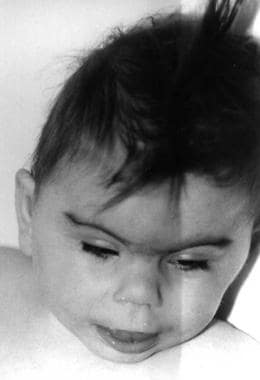 Case study 1. Classic de Lange phenotype is shown. Facial characteristics of a 10-month-old girl are pictured. Note well-defined eyebrows with synophrys, depressed nasal bridge, and long smooth philtrum.
Case study 1. Classic de Lange phenotype is shown. Facial characteristics of a 10-month-old girl are pictured. Note well-defined eyebrows with synophrys, depressed nasal bridge, and long smooth philtrum.
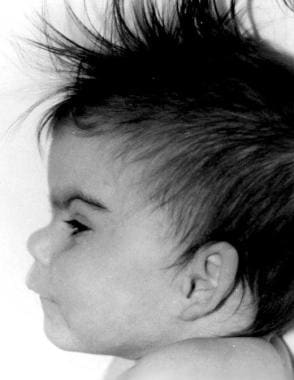 Case study 1. Lateral facial profile is pictured. The eyebrows are neat, arched, and well defined. The nasal bridge is depressed, and the nares are upturned.
Case study 1. Lateral facial profile is pictured. The eyebrows are neat, arched, and well defined. The nasal bridge is depressed, and the nares are upturned.
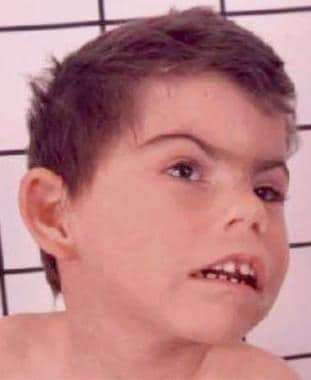 Case study 1. The patient, aged 5 years, is shown; note microbrachycephaly, well-defined eyebrows, anteverted nares, long and thin upper lip, down-turned angles of mouth, and widely spaced teeth.
Case study 1. The patient, aged 5 years, is shown; note microbrachycephaly, well-defined eyebrows, anteverted nares, long and thin upper lip, down-turned angles of mouth, and widely spaced teeth.
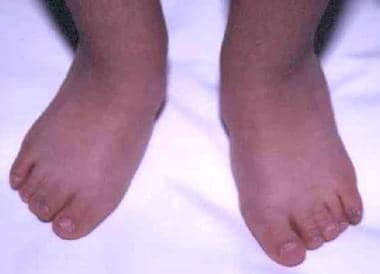 Case study 1. Small feet with short hypoplastic toes and syndactyly of the second and third toes is pictured.
Case study 1. Small feet with short hypoplastic toes and syndactyly of the second and third toes is pictured.
Growth retardation
Retardation of growth, often of prenatal onset, is one diagnostic criterion for CDLS that can also help to discriminate classic cases from mild cases. [53, 65, 66] Profound prenatal growth deficiency (>2.5 standard deviations below the mean for gestation) becomes more severe postnatally (>3.5 standard deviations below the mean) and is characteristic for classic (type I) CDLS. Birth weight greater than 2500 g and less marked postnatal growth deficiency may help to classify a patient as having mild (type II) CDLS.
Growth persists below the normal curves in most of the patients throughout life.
Height velocity is equal to the reference range, and weight velocity is below the reference range throughout life until adolescence.
Skeletal abnormalities
Skeletal abnormalities characteristic for classic CDLS include major longitudinal reduction abnormalities of the upper limbs, including hypoplastic or absent ulnas and/or oligodactyly (which, if bilateral, can be asymmetric). This abnormality is not observed in persons with mild CDLS. [36, 65]
Severe malformations of the lower limbs are less common than upper limb anomalies. The limb findings in 378 individuals with CDLS presented by Mehta et al demonstrate a consistent pattern of laterality and symmetry involvement, and with increased severity of the right-side in individuals with asymmetric limb defects. [67]
Most patients have relatively small hands, feet, or both.
Limitation of extension at the elbows with accompanying radiological characteristics may help with the diagnosis because they are not frequently observed.
Other minor variable anomalies, such as shortened fourth metatarsal, clinodactyly, single palmar crease, digits hypoplasia, proximal placement of the thumb(s), and syndactyly of toes 2 and 3 are frequently observed in many other syndromes or in healthy individuals; therefore, they are of limited diagnostic aid.
Cutaneous manifestations
Common cutaneous manifestations include hypertrichosis in the form of synophrys, long eyelashes, and hirsutism on the back. [36, 48]
Cutis marmorata is noted in CDLS patients.
Hypoplastic nipples and umbilicus are observed most commonly in persons with the classic type and are observed less frequently in those with the mild phenotype.
Multiple capillary or cavernous hemangiomas are occasionally reported; these hemangiomas may cause the observed thrombocytopenia that is reported, most likely occurring as a result of a slow, consumptive coagulopathy. [47, 68, 69, 70]
Multiple pigmented nevi were observed incidentally. [71]
Ulerythema ophryogenes was reported in a 17-year-old girl with Brachmann-de Lange syndrome (BDLS). [72]
See the images below.
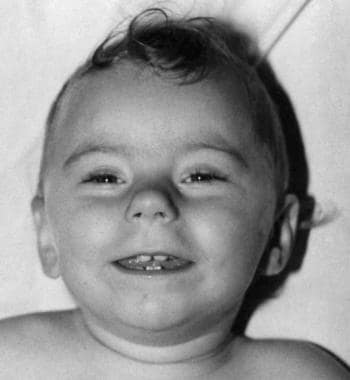 Case study 2. Mild de Lange syndrome is shown. The face of a 1.5-year-old girl is pictured. Note neat eyebrows with delicate synophrys, long eyelashes, depressed nasal bridge, upturned nares, long philtrum, thin upper lip, and small chin.
Case study 2. Mild de Lange syndrome is shown. The face of a 1.5-year-old girl is pictured. Note neat eyebrows with delicate synophrys, long eyelashes, depressed nasal bridge, upturned nares, long philtrum, thin upper lip, and small chin.
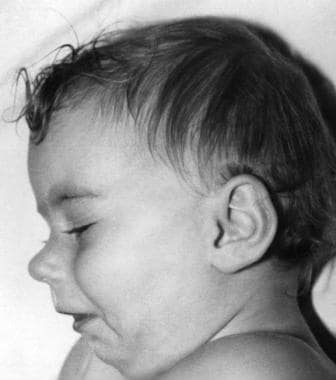 Case study 2. Lateral facial profile shows depressed nasal bridge, thin upper lip, and small mandible.
Case study 2. Lateral facial profile shows depressed nasal bridge, thin upper lip, and small mandible.
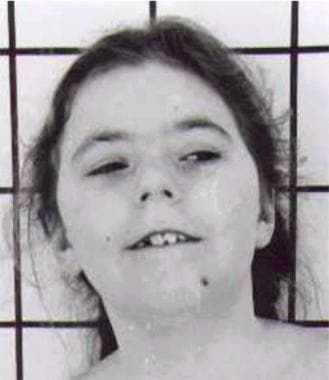 Case study 2. The patient, aged 8 years, is shown; note delicate synophrys of the eyebrows, upturned nares, long philtrum, and thin upper lip.
Case study 2. The patient, aged 8 years, is shown; note delicate synophrys of the eyebrows, upturned nares, long philtrum, and thin upper lip.
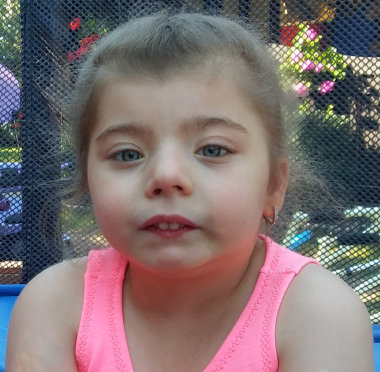 Case study 3. de Lange syndrome patient. Six-year-old patient with HDAC8 mutation. Some distinct clinical features such as hypertelorism and hooding of the eyelids are more characteristic for this type of mutation.
Case study 3. de Lange syndrome patient. Six-year-old patient with HDAC8 mutation. Some distinct clinical features such as hypertelorism and hooding of the eyelids are more characteristic for this type of mutation.
GI problems
GI problems occur with high frequency, and they contribute to feeding difficulties and failure to thrive. [36, 73, 74, 75]
Pyloric stenosis is the most frequent cause of persistent vomiting in the newborn period.
GER and its sequelae are thought to be the most underappreciated medical problems in persons with BDLS. Approximately two thirds of children are first seen with clinical signs that might be referred to this area. [76, 75, 77]
Pathological GER was found in 65% individuals. Silent GER can cause esophageal damage and symptoms of pulmonary congestion and irritation due to chemical pneumonitis. [36, 74, 75]
The most severe complications of GER include Barrett esophagus and the Sandifer complex, which is characterized by torticollis, opisthotonus, and paroxysmal dystonic posture. [40, 77, 78]
Two other GI-related problems are intestinal malrotation with volvulus [79] and congenital diaphragmatic hernia. [80, 81] The latter anomaly might be more common than initially realized.
Omphalocele was reported in one patient. [82]
Constipation occurs in 30% of patients, more often in adolescence and adulthood.
Gallstones are not so rare in CDLS children and adults.
The occurrence of sudden death caused by peritonitis has been noted.
Cardiovascular problems
Cardiovascular problems in the form of congenital heart malformations are diagnosed in approximately 14%-70% of children. Most common are ventricular and atrial septal defects, pulmonic stenosis, and ventricular septal defect; various other anomalies occasionally occur. [36, 61, 83]
Respiratory problems
Most respiratory problems are probably initiated and/or complicated by undetected GER. Upper respiratory tract infections and pneumonias are reported in 25% of individuals. Severe complications due to bronchopulmonary dysplasia have also been described. Choanal atresia was diagnosed at birth in 3 children. Cleft palate occurs in 30% of patients.
Hearing problems
Hearing problems occur frequently. [36] Hearing deficits from mild to severe may be present in 60-100% of all CDLS patients. Stenosis of the external auditory canals is found in 80% of examined children. Hearing aids are poorly tolerated.
Ophthalmologic problems
Ophthalmologic problems occur in a high proportion of children with CDLS. [40, 84, 85, 86] Myopia was reported in 60% of patients, ptosis in 45%, nystagmus in 37%, microcornea in 21%, and nasolacrimal duct obstruction in 16%. Chronic blepharitis is a frequent complication. Glasses are poorly tolerated.
Other problems
Urinary tract anomalies are common and include hydronephrosis, urethral reflux, subcortical renal cysts, and renal dysplasia or hypoplasia. [12, 87]
There is a significant rate of autonomic neuropathy among patients with CDLS. [113]
Male hypogonadism and cryptorchidism are present in more than half the boys. [36, 76]
Seizures are reported in 23-26% of individuals. [36, 40, 88]
Heat intolerance and absence of pain sensation have been observed in several patients. [36]
One described patient had rosacea, most likely an incidental finding. [89]
Chronic ear infections, respiratory infections (mostly viral), and sinus infections are common in CDLS patients, although immunologic tests revealed rather normal results. [61]
-
Case study 1. Classic de Lange phenotype is shown. Facial characteristics of a 10-month-old girl are pictured. Note well-defined eyebrows with synophrys, depressed nasal bridge, and long smooth philtrum.
-
Case study 1. Lateral facial profile is pictured. The eyebrows are neat, arched, and well defined. The nasal bridge is depressed, and the nares are upturned.
-
Case study 1. The patient, aged 5 years, is shown; note microbrachycephaly, well-defined eyebrows, anteverted nares, long and thin upper lip, down-turned angles of mouth, and widely spaced teeth.
-
Case study 1. Upper limb reduction anomalies are pictured with only 2 fingers present.
-
Case study 1. Note short hypoplastic fifth finger.
-
Case study 1. Small feet with short hypoplastic toes and syndactyly of the second and third toes is pictured.
-
Case study 2. Mild de Lange syndrome is shown. The face of a 1.5-year-old girl is pictured. Note neat eyebrows with delicate synophrys, long eyelashes, depressed nasal bridge, upturned nares, long philtrum, thin upper lip, and small chin.
-
Case study 2. Lateral facial profile shows depressed nasal bridge, thin upper lip, and small mandible.
-
Case study 2. The patient, aged 8 years, is shown; note delicate synophrys of the eyebrows, upturned nares, long philtrum, and thin upper lip.
-
Case study 2. Lateral facial profile of the patient, aged 8 years, is shown.
-
Case study 3. de Lange syndrome patient. Six-year-old patient with HDAC8 mutation. Some distinct clinical features such as hypertelorism and hooding of the eyelids are more characteristic for this type of mutation.

